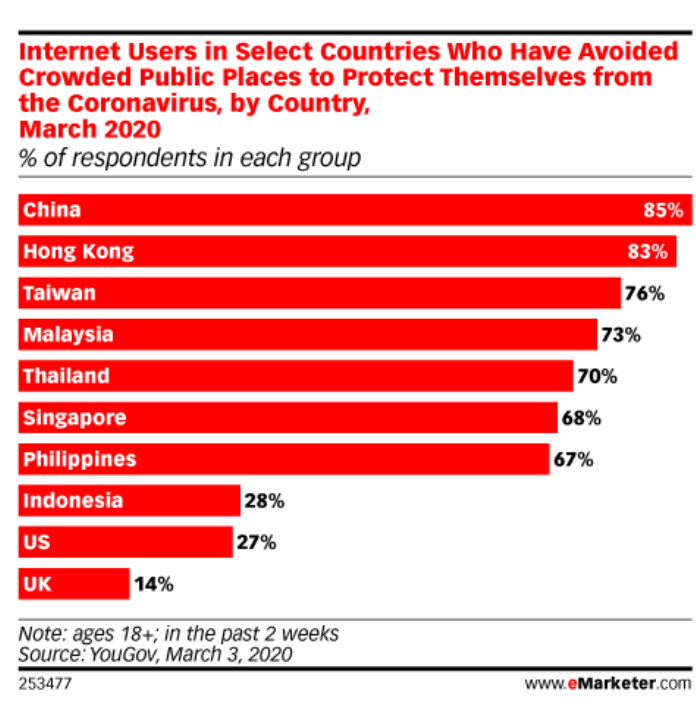According to Michael Leboeuf, “A satisfied customer is the best business strategy of all”. In other words, it simply means put the customer first by understanding their needs and behavioral patterns and then map it backwards to your products.
Due to the increased adoption of smartphones, faster networks, and increasing consumer propensity to spend, the global ecommerce sales was expected to reach $6.5 trillion by 2023, with a penetration rate of 15%.
This was based on customer and market research in a pre-COVID world. But, the current COVID-19 pandemic has altered the market landscape and consumer behavior beyond recognition. The penetration rates are expected to increase to 25% by 2025.
According to the recent National Retail Federation (NRF) survey, these are some of the key consumer behavioral changes that are affecting retailers, like you:
- 9 in 10 consumers have changed their traditional shopping habits due to COVID-19
- More than half of the consumers have ordered products online that they would normally purchase at the store
- Nearly 6 in 10 consumers say they are worried about going to the store due to the fear of being infected
In a pre-COVID world, traditional enterprise retailers largely focused on driving growth, acquiring higher market share, increasing footfalls to their physical stores – instead of prioritizing the building of an online presence.
But, the current COVID-19 crisis has altered consumer behavior in 2 major ways:
- The reluctance to mingle in crowded public places, due to governmental lockdowns or personal health precautions
- The rapid migration to e-commerce websites and mobile apps
This is highlighted in an emarketer report that shows that:
- 85% of people in China continue to avoid crowded places
- On an average 68% of people in the US, between the age groups of 18 – 44 are likely to avoid visiting physical stores

What does this mean for offline retailers like you?
You need to be agile in adapting to these changes – accepting and embracing the new normal is crucial. A missed inflection point has cost a lot for brands in the past like Kodak and Nokia.
You don’t want to and can’t afford to miss the bus right now!
In such a scenario, you can reshape your business strategy on 2 pillars built on the foundation of customer data:
1. Digital Transformation
What does this mean in the retail industry?
It simply means two things:
- online presence
- omnichannel experience
Let’s consider the Future Group-owned BigBazaar in India as an example.
With the increase in demand for staples and household supplies amidst this pandemic, the Future Group launched BigBazaar.com and stepped up their efforts to service customers online, building omnichannel models within ten days that have since then scaled to about 10K orders per day.
Strengthening your online presence and continuing to deliver customer value is well within your grasp!
Your digital transformation journey can be broken down into 2 steps:
- Data Collection
- Converting Data into Useful Insights
(i) Data Collection:
It is very important to inculcate a data-first mind set. It is not about one single metric that you need to pay attention to, at the same time it’s not hundreds either. And, the basis of these metrics stems from a Unified Customer View.
What is a Unified Customer view?
It is capturing diverse data-points about every single customer both online and offline, across all channels and devices.
As a retailer, why do you need it?
The ongoing digitalization has resulted in a new generation of customers who use different channels and different devices during their buying journey. Today’s consumers are ultra-connected, increasingly empowered to get in touch with brands however and whenever they want, and hyper-aware that these businesses are collecting information about their behavior and preferences every step of the way. They expect that the brands will use this information to provide seamless, personalized experiences across each interaction — regardless of whether the touch point is digital or live.
How do you tackle this?
Companies with a strong Omnichannel customer engagement are able to retain 89% of their customers, compared to 33% for companies with a weak omnichannel customer engagement.
A simple CRM or a Data Management Platform will not help you retain 89% of your customers, you need to have a Customer Data Platform (CDP) in place.
Why do you need a Customer Data Platform (CDP)?
- CDP uses only first party data (data collected by your company):
First party data is the data that comes directly from your audience. It gives you an insight into how your customers and website visitors behave and what their preferences are. With first-party data you don’t have to guess what your customers like – you have the information directly from the source. You can capture demographic, geolocation, device-related, and behavioral data-points such as:
- Date/time
- Location
- Device type/model,
- IP/Browser version
- Items purchased online
- Frequency of purchase
- Preferred method of payment
- Eyeball data: seen and not clicked
Using this first party data you can develop a rich individual customer profile. These unique profiles get enriched in real-time by capturing data with every customer interaction across your website, mobile app, marketing campaigns and in-store purchases.
- CDP focuses on the entire lifecycle of customer’s actions:
When as a retailer you are looking into strengthening your online presence in order to deliver a seamless omnichannel experience, it is very important to import data from in-store purchases. By combining your offline sales data with your e-commerce first party data, you can get a holistic understanding of the purchase behaviors of your customers. This can give you insights into which products are most popular and what types of customers prefer which products.
All this as a retailer helps you to create a Unified Customer View.
- CDP helps you to improve Customer Lifetime Value:
Siloed data prevents you from creating a consistent and hyper – personalized omnichannel customer experience. With CDP this problem is solved, by gathering first-party data and by unifying customer data across all channels and devices, CDPs enable the most effective marketing decisions powered by accurate data.
This will empower retailers like you to deliver a seamless hyper – personalized experience across the customer’s journey with your brand thus ensuring that they will keep coming back to you.
(ii) Converting Data into Useful Insights:
Once you have collected relevant first party data and you have your CDP in place, making sense of data and using it to drive business strategy is the next important step you should focus on. You can now effortlessly create customer segments based on certain defined data-points.
For instance: If you are a fashion retail brand, you can build out laser-focused segments based on geolocation, past purchased products, products viewed but not clicked, products viewed and products added to cart, preferred categories, frequency of purchase, etc.
The more granular your customer segments, the more targeted and effective your multi-channel marketing strategy will be.
2. AI-led Hyper-Personalization
Merely equipping yourself with actionable insights and not identifying the right messaging, products, and offers to showcase your digital customers is a lose-lose proposition!
You need to then converting these insights into profitable actions
You ask, why?
Let me take Colin Cherry, a cognitive psychologist’s help.
In the 1950’s he coined and explained a term called ‘The cocktail party effect’. At a cocktail party, you will talk to several people and engage in several conversations. You will tune in and out, remembering very little from most of your interactions. But then someone says something that actually interests you and is relevant to you, that conversation will receive your full attention.
Your mind will not only remember the details of the conversation, but you will also remember the person who spoke. This will compel you to come back to that person to have more such interactions.
A 360-degree view of your customers allows you to create ‘The cocktail party effect’ or what we call Hyper – Personalization for your customers.
What will this help you address?
(i) Onsite product discovery is no more a problem:
59% online shoppers believe that it is easier to find the products they like on personalized online retail stores. A few use cases to achieve the same:
- Category page reordering: For any ecommerce platform that operates at scale, there is a large number of products in the product catalogues. If the customers can’t find what they are looking for easily or if they spend too much time, they will leave the website.
Our AI engine, Raman, predicts user interest, and you can reorder the sequence in which the products are displayed. Since the most relevant products to that particular user is shown at the top, it makes it easier for the customer to find the products they are interested in. This can lead to 60-80% increase in CTRs.
- Create smart segments based on certain defined data points (in sync with your KPIs).For instance, if you are an ecommerce retail app/web – track the geo location , behavioral data , frequency of purchase , past purchase etc. . Using this data you can create a hyper-personalized end to end journey – both product recommendations and messaging for each customer.
(ii) Lower costs and higher customer engagement rates:
59% of marketers are experiencing good ROI after personalizing their online stores.
Our AI engine, Raman will help you analyze the most preferred channels where a customer is more likely to respond based on historical responses with your marketing campaigns.
For instance if Customer-A is more likely to respond and convert via emails and Customer-B is more likely to respond and convert via app push notifications. Spend money only on that – thus lowering your costs.
Orchestrate intelligent customer journeys to effectively engage with customer segments on preferred channels to achieve your conversion goals. Send personalized product recommendations and personalized content on the customer’s preferred channel. This means you can offer customers personalized customer engagement messages offline when the user is not active on your web or app. Thus ensuring quality customer engagement rates at a minimal cost.
(iii) Higher retention rates leading to increased CLTV:
56% of Online shoppers are more likely to return to a site that offers product recommendations. Go beyond clickstream data. Capture crucial eyeball data-seen and not clicked , other behavioral data like products added to cart, wish list, frequency of purchase offline purchase, etc. to offer predictive personalized product recommendations via product recommendation widget.
Create personalized virtual boutique for every unique user-consisting of product recommendations across categories based on data and Raman predictions. Doing this will help you achieve 120-150% higher CTRs
The Ball is in Your Court!
We all knew that the world was turning digital, but due to COVID-19 the pace has suddenly increased exponentially.
Fortifying your business strategy in response to the new normal, built on the pillars of Digital Transformation and AI-led Personalization, is critical to survival and future success.
To learn how you can get started on your personalization journey and increase conversions by 8-13%, get in touch, today!
 Growth, decoded: Agentic Marketing Predictions 2026 for consumer markets. Read the report now.
Growth, decoded: Agentic Marketing Predictions 2026 for consumer markets. Read the report now. 









